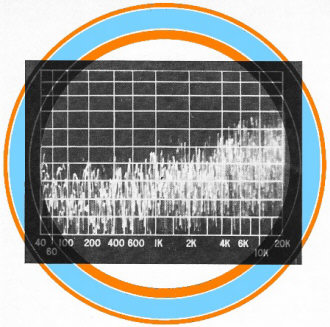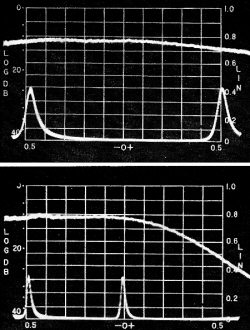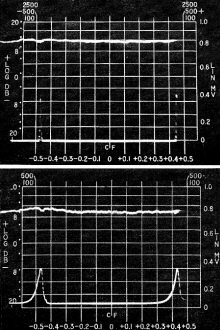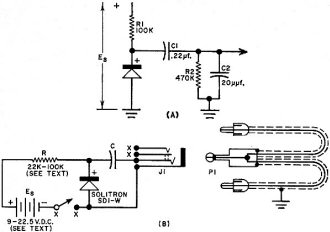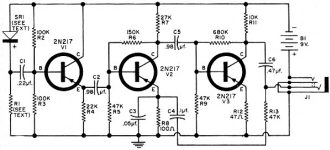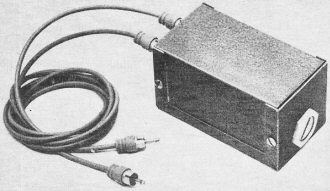White Noise / Its Nature, Generation, and Applications
|
|
Author Lon Edwards provided a good introductory lesson on the subject of white noise. Since digital communications was not yet a major technology when the piece appeared in a 1962 issue of Electronics World magazine, pink noise, a pseudorandom version of the truly random nature of white, was not a concept well known in the electronics realm. White noise in the audio spectrum is the focus here, but the general principles apply at all frequencies. Interestingly, he states, "The word 'white' has been borrowed (inaccurately) from optics and is used to mean the long-time average energy distribution of the electrical voltages over a specified frequency spectrum." Solitron Devices (still in business), where Mr. Edwards was employed, manufactured a noise diode they called the Sounvister SD1−W, a double-diffused, silicon junction diode. An Internet search did not turn up a single instance of a surviving Sounvister. Lon Edwards was awarded patent US3675148A in 1969 for his noise diode. White Noise / Its Nature, Generation, and Applications White noise, a special type of random noise with uniform energy distribution, can be used to test many types of audio equipment. It is also used as audio all analgesia and in a number of different industrial test applications. By Lon Edwards / Solitron Devices, Inc. White noise is an often used, but hazily understood, term. Does white describe the color of the noise? It hardly seems possible. Yet noise is also described as pink and yellow. There is a precise meaning of white noise as used in electronics. A study of the origin and meaning of white noise will be a good introduction to considering a white-noise generator as a device for testing hi-fi components. Most people can hear sound from vibrations ranging from about 20 to 20,000 cps if the energy reaches the inner ear. These lower and upper limits differ somewhat from person to person and, for one person, from time to time as well as with age. Vibrations within the range of 20 to 20,000 cps will be called the vibration spectrum. The word "sound" will be reserved for those sensations one recognizes when energy from vibrations reach the inner ear. When vibrations are such that one perceives a pattern in the sound, a special term is used to describe the sound. For example, when a vibration is repeated for a long enough time, the sound is called a musical tone. If the tone is given a position higher or lower than other tones in a musical scale, its position is described as pitch. Thus a repetitive vibration of 440 cps results in a musical tone defined by international agreement as the standard musical pitch and designated as At on the musical scale.1 In practice this pitch is taken from a tuning fork adjusted accurately and producing a nearly pure sine-wave. Other tones are related to this standard in a manner so as to comprise some sort of musical scale. To help understand the idea of noise, imagine 19,980 tuning forks (one for each frequency between 20 and 20,000 cps) each capable of producing either a single cycle, several cycles, or many cycles of sound. Furthermore, each is to generate a pure sine-wave. Now, if it is possible to (1) cause each fork to vibrate for different lengths of time interspersed with periods of rest in random order and (2) keep all forks acting in a random relation to each other, the cacophony would be called random noise. All possible pitches might be heard, but in no distinguishable pattern. Such a chaotic condition might also be described as one of high entropy, i.e., the vibrations are considered to be unorganized, based on the sound heard. Fig. 1 - Response of white-noise generator/amplifier in Fig. 4. Output is 0.75 v. r.m.s. across a 100,000-ohm load. Pips are at 0 and 50 kc. Fig. 2 - Response of same amplifier/generator with pips at 0.1 kc. (left); 0.5 kc. (right). Panoramic SPA-3 Spectrum Analyzer was used. White noise refers to a special type of random noise. Suppose each tuning fork is driven with a different amount of energy, i.e., each would produce a few cycles of varying amplitude energy from time to time. If this variation is now added to the two previously described conditions, the instantaneous energy of a particular fork will change constantly. Suppose we consider the instantaneous energy of each of 100 forks, say those of 200 to 299 cps. The relation of amplitude and phase of each to the others would be continually shifting in random fashion. Now suppose we measure the average energy of the 100 forks over a long period of time, say 100 minutes. We would find the average energy to be X. If we measure the average energy from many other 100-fork groups picked at random in the spectrum, we will find the average energy for 100 minutes for each group of 100 forks, irrespective of frequency, also equal to X. We now have the special condition referred to as "white." Under this condition, although the instantaneous energy of each fork changes, the long-time average for any 100 forks equals that for any other 100 forks. Noise from these forks would be called white noise rather than random noise. While all pitches could be heard in random order, the long-time average energies of the vibrations responsible for them would be equal. Thus, the vibrations for white noise are organized as far as long-time average energy is concerned but are random as far as instantaneous energy and order of frequency with time is concerned. Neither the instantaneous energy of a particular frequency nor the time of its appearance can be determined; both are random. However, in terms of statistical probability, the long-time energy per bandwidth can be predicted accurately. To this point we have considered noise as a perception phenomenon and white as a particular kind of energy distribution in time. In electrical work, the concept of noise as just described (from acoustics) has been used to refer to any voltages that seem to be randomly active in a conductor. The word "white" has been borrowed (inaccurately) from optics and is used to mean the long-time average energy distribution of the electrical voltages over a specified frequency spectrum.2 This meaning for white in electrical work has become so well established it is best to continue to use it, optics not−withstanding. Hi-Fi Equipment Testing Before describing a practical white-noise generator, let's digress to talk about using white noise to test hi-fi systems.3 The most useful objective check on the performance of any electrical or acoustical system would be obtained if it could be made while the system is stimulated by the exact energy patterns it is to handle in practice. This can be done when the energy pattern is simple and standardized, i.e., sinusoidal. But only rarely can it be done when the energy pattern to be handled is both complex, and to the system, randomly organized. A prediction of the practical performance of systems in the latter category, such as hi-fi amplifiers and speakers, is often based upon their performance when stimulated by the sine-waves, tone bursts, sweeping sine-waves of varying frequency, square waves, and so on. In this process, the area of no-data gaps, i.e., those segments of the total audio spectrum which lie between test stimulation points and performance stimulation points, depend on the degree to which the test signal duplicates the performance signal. The no-data areas between sine waves and music-energy waves are both frequent and large. Predicting the performance of a hi-fi system on music energy from its performance with sine-wave test energy amounts to basing the predictions on very few data; the probability of accuracy is low. This may account, in part, for the widely recognized discrepancy between performance predicted from technical specifications and the actual performance of the systems. On the other hand, testing the system with electrical impulses that are random both as to amplitude and frequency over the spectrum of interest, maintaining constant energy per bandwidth, reduces the no-data gap areas between test and performance stimulation points. This idea is even more sound when you consider that music can be conceived of as tones (energy of low entropy) organized into a pattern of sufficiently high entropy (approaching randomness) to provide a desired degree of sophistication.4 If one accepts this concept of music, perhaps it follows that music-handling systems can be tested best with white noise, a signal of high entropy. If these arguments are accurate, then white noise should be useful in making objective tests on the performance of amplifiers, loudspeakers, cartridges, as well as the acoustic performance of auditoriums and music listening rooms in the home. White-Noise Generator Fig. 3 - Basic white-noise generator has 500-2500 microvolt output. Fig. 4. Complete schematic of a white-noise generator/amplifier. R1 - 22,000-100,000 ohm, 1/2 w. res. (see text) Fig. 5 - Author's generator is built in chassis box, has two outputs. In spite of the previous theory, there is little reference to white noise testing in popular literature. There may be many reasons for the apparent failure to exploit its capabilities among which have been the cost and complexity of suitable white-noise generators. This is no longer a deterrent. A silicon diode called the Sounvister is available in different types to cover the spectrum from less than 1 cps to more than 100 mc.5 Among these, the SD1-W is designed for the 20-20,000 cps spectrum. It is the white-noise source in the compact generator to be described. The SD1-W is a double-diffused, silicon junction diode. When a reverse voltage, applied to the SD1-W in the circuit in Fig. 3A, is gradually increased, the diode produces an increasing amount of random, non-white voltage. At some point, the diode suddenly goes into zener or avalanche operation with a resulting generation of reasonably white noise. As E, is increased, the output drops and "whitens" even more. Typical diodes have an output ranging from 500 to 2500 microvolts r.m.s. per 20 kc. bandwidth. Each SD1-W is accompanied by a specification sheet which suggests operating parameters for best performance of that particular unit. If the output from the diode alone is sufficient, the circuit of Fig. 3B can be used. For greatest simplicity, the energizing voltage, Es, can be specified as the nominal voltage of a small battery, such as 9 or 22.5 volts, when ordering an SD1-W diode. Since the current drain usually is under 500 microamperes, even the smallest battery will have a long operating life. The switching-type jack in Fig. 3B can be dispensed with and the unit can be allowed to operate continuously. Resistor R1 is selected to adjust the current to that value recommended when a voltage other than the classifying voltage is used. The SD1-W diode is equivalent to a high-impedance generator and should not be used across a load much smaller than 100,000 ohms. A simple transistor amplifier can be used to boost the out-put of a selected SD1-W to an r.m.s. value somewhere between 0.25 and 1.0 volt across a 100,000-ohm load. An amplifier built by the author for this purpose is shown schematically in Fig. 4. The white-noise diode, SR1, used in this amplifier was selected to operate correctly with an energizing voltage of 9.0 volts. V1 is used as an emitter-follower to provide a high-impedance load for SR1. V2 and V3 are straightforward amplifier stages. C2 and C5 are obtained by paralleling two high-value 0.47-μf. capacitors. R13, C3, and C4 form a frequency-selective feedback loop to compensate for departures from linearity of both the diode and the amplifier. The completed generator installed in a case with two connecting leads for stereo systems is shown in Fig. 5. Response curves for the output of a typical generator are shown in Figs. 1 and 2. Marker pips appear at 1 kc., 5 kc., and at 50 kc. Several generators have been built using un selected 2N217 transistors and have performed as follows: Output - between 0.25 and 1.0 r.m.s. volt across a 100,000-ohm load. Frequency Response - 20-20,000 cps, ±2db. Current Drain - between 1.0 and 1.5 ma. Applications The author has found white noise to be useful, not only in development work, but also with complete hi-fi systems. It will reveal differences in acoustic performance of speaker systems more readily than any method yet tried. Harshness, boom, and hollowness can be detected readily. Of course, one cannot tell from the sound of white noise alone which system is best for music reproduction. But once a standard system has been selected, reproduction of white noise is an excellent method for checking balance and matching channel response. And, finally, acoustic response of the listening room to all frequencies can be judged qualitatively by simply playing white noise and walking around the room noting the variations in its character. White noise is also being used in many ways in modern technology. Properly shaped, it provides the "waterfall" sound for audio analgesia. It can provide constant-level sound against which hearing ability can be measured or it can mask outside sounds which might invalidate results from laboratory experiments with animals. It can generate random numbers to test computers, simulate cosmic noise, calibrate astronavigational and tracking systems, provide a reference level for setting the sensitivity of receivers and activate shaker tables for component testing. References 1. Culver, C. A.: "Musical Acoustics," McGraw-Hill Book Co., pg. 86. 2. Bennett, W. R.: "Electrical Noise," McGraw-Hill Book Co., pg. 14. 3. Terman, F. E. & Pettit, J. M.: "Electronic Measurements," McGraw-Hill Book Co., New York, pgs. 353·379. 4. Olson, H. F. & Belar, H.: "Aid to Music Composition Employing a Random Probability System," AES Convention paper No. 188. 5. Edwards, L. E., et al.: "White-Noise Manual, Featuring the Sounvistor White-Noise Diode," Solitron Devices. Inc.
Posted November 1, 2022 |
|

